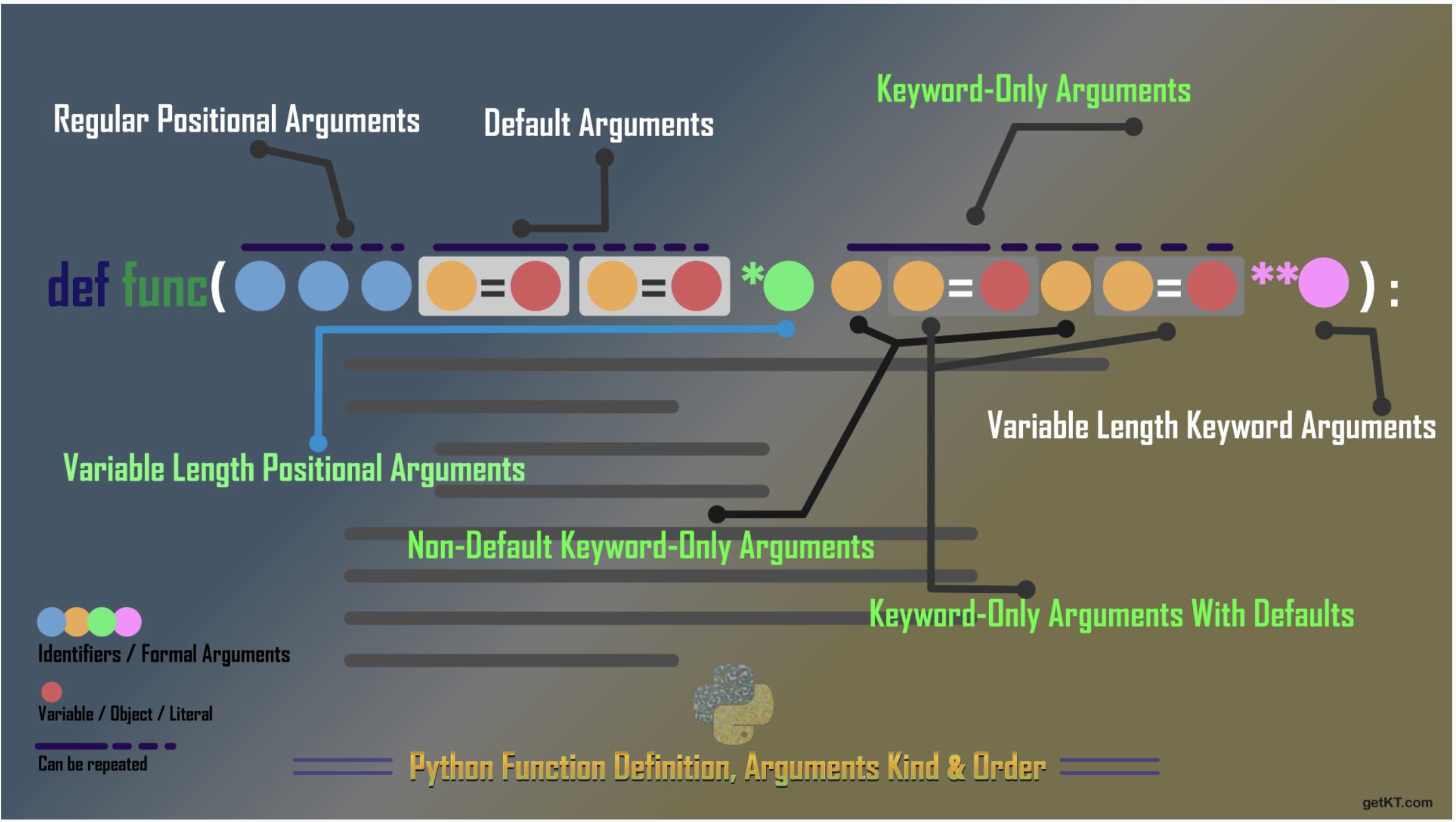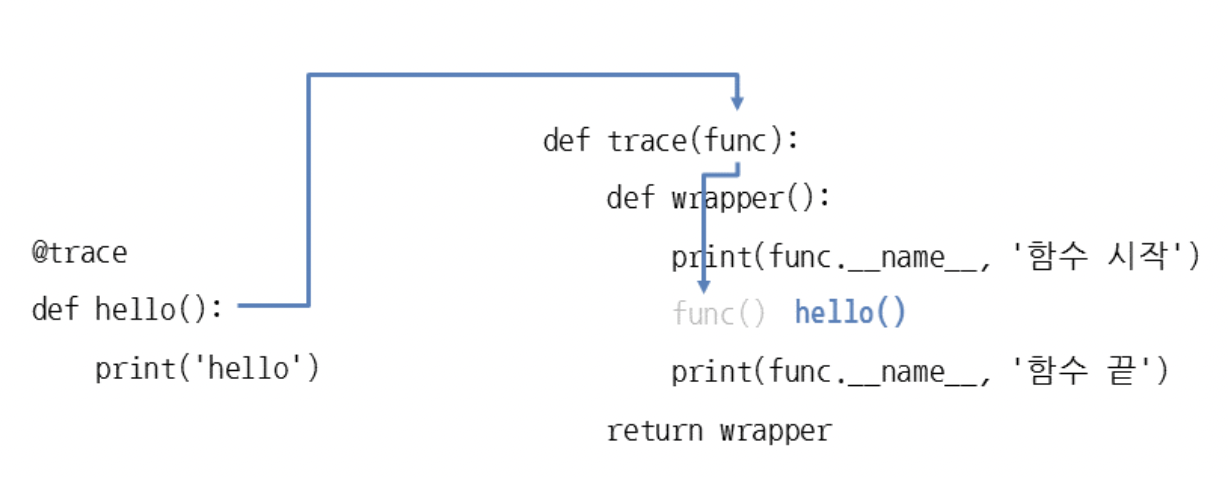🤷 기간 : 2021.04.15 ~ 2021.04.18
🤷 자료 : replit.com
🤷 내용: python
함수 쓸 때 참고해
- 함수 만들 때 인수 지정을 안했을 때
def shin():
return a+b
a = 1 # 함수 안의 값 들을 지정해 두면 된당
b = 2
print(shin()) # 3 나옴- 함수 만들 때 인수 지정 했을 때
def shin(a,b):
return a+b
print(shin(1, 2)) # 3 나옴 / 프린트 할때 해주면 된다-
def shin():
return a+b
print(shin(1, 2)) # 에러 뜸 / a,b 값을 미리 지정해 둬야된당 Literal string interpolation
- 언제 사용하나요 ?
- 길고 복잡한 문자열을 출력 할 때 유용
- 사용 방법
print(f"{ } 문자ABC")
>>> name = "shin" >>> print(f"hello, {name}") # 변수 여러개를 해서 추가할 수도 있다. hello, shin
Comparison Operators
>: 숫자 뿐 아니라 문자(str)에도 사용이 가능하다
if character > "b":
print("b 보다 크면 c 혹은 그 다음 알파벳들중 하나 이겠군요?")if character < "b":
print("b 보다 작으면 a 이겠네요!")Assignment #25
수학 ..^^ 와이리 어렵누 ^^ 잘못 생각하고 있었넹 ㅋㅎ
다음의 방정식을 해결하는 프로그램을 구현 하세요. x값을 구해야 합니다.
ax = b결과 출력물은 다음과 같아야 합니다.
- Input 으로 주어진 a 와 b 값으로 위의 방정식을 충족하는 단 하나의 정수가 존재한다면 해당 정수를 출력하면 됩니다
- 만일 a 와 b 값으로 위의 방정식을 충족하는 정수가 없다면 "No Solution"을 출력해주세요.
- a 와 b 값으로 위의 방정식을 충족하는 정수가 많다면 "Many Solutions"을 출력해주세요.
Hint:
- a 나 b 는 0이 될 수 있습니다.Examples:
- 만일 a = 1, b = -2 라면 결과값으로 -2가 출력이 되어야 합니다.
- 만일 a = 2, b = -1 라면 결과값으로 "No Solution"이 출력이 되어야 합니다.제출완료
a = int(input("첫 번째 숫자를 입력해주세요: ")) b = int(input("두 번째 숫자를 입력해주세요: ")) ` if a == 0 and b == 0: # 둘다 0 이면 x값이 암꺼나 나와도 되니까 print("Many Solutions") # 매니솔류션 elif a ==0 and b != 0: # a만 0이면 뭘 넣어도 안되니까 print("No Solution") # 값이 없지 elif a != 0 and b == 0: # b만 0이면 x값은 0만 나올 수 있징? print(0) # 그래서 0 elif a != 0 and b != 0: # 둘다 0이 아닐때 print(b/a) # x값 출력 하고 if b%a != 0: # 나머지 값이 0이 아니면 = 실수(float) 이면 print("No Solution") # 답없당 ~
Function Parameter
Positional Parameter:- 가장 기본적인 형태, 순서가 바뀌면 출력값도 바뀌겠지 당요니 ?
def love_you(my_name, your_name):
print(f"{my_name} loves {your_name}")
love_you("정우성", "아이유") # 순서에 맞게 값을 넣어 준다.
정우성 loves 아이유Keyword Arguments:- 이름으로 맞추어서 값을 전해줄 수 있으며, 순서가 뒤바껴도 됌
def love_you(my_name, your_name):
print(f"{my_name} loves {your_name}")
love_you(your_name="아이유", my_name="정우성") # 순서가 아니라 이름에 맞게 넣어줘서 값은 위와 똑같당
정우성 loves 아이유Mixing positional argumentsandkeyword arguments:keyword arguments는 순서가 바뀌어도 상관 없지만 /positional arguments부분은 순서를 지켜줘야 한다는 것입니다.
def love_you(my_name, your_name):
print(f"{my_name} loves {your_name}")
love_you(your_name = "아이유", "정우성") # 키워드 아규먼트는 위치 상관 ㄴㄴ, 근데 "정우성"이 my_name쪽에 있으려면 앞으로 가야 겠지? 그래서 이게 안되는거약/ 요건 your_name이 값이 2개가 되는 느낌이지
오류..def love_you(my_name, your_name):
print(f"{my_name} loves {your_name}")
love_you("정우성", your_name = "아이유")
정우성 loves 아이유Parameter Default Value:값이 넘겨지 않은 경우default 값이 자동넘어간다- 문제는
default 값이 정의된 parameter가,default 값이 정의 되지 않은 parameter보다 먼저 위치해 있으면 안된다 - 일단 어떻게
default값을 주나 ?
- 문제는
def love_you(my_name, your_name="아이유"): # 함수에 미리 때려박아 놓는거지 이때 인수 순서가 바뀌면 안되용
print(f"{my_name} loves {your_name}")
love_you("정우성")
정우성 loves 아이유[Parameter order]
def func(Regular Positional Arguments,Default Arguments,Variable Length Positional Arguments,Keyword-only ArgumentorKeyword-only Argument with default,Variable Length Keyword Arguments)- 예제
def func(a,b,c = "shin",*args,a(keyword)orman=True(keyword),kwargs)
Set
-
list와 다른점 ?- 요소들이 순서대로 저장되어 있지 않습니다. 즉 ordering이 없다.
-
그에따른 특이점 ?
for 문에서 읽어들일때 요소들이 순서대로 나오는게 아니라 무작위 순서대로 나옴.- 순서가 없으므로
indexing도 없음 - 중복된 값을 저장할 수 없음. -> 새로 저장하려고 하는 요소와 동일한 값의 요소가 존재한다면 새로운 요소가 이 전 요소를 치환(replace) 한당
>>> set1 = {1, 2, 3, 1} >>> print(set1) {1, 2, 3} >>> set2 = set([1, 2, 3, 1]) >>> print(set2) {1, 2, 3} -
Look up 가능띠
if 문에서in키워드 사용해서 찾아보자 ~ ?
my_set = {1, 2, 3} if 1 in my_set: print("1 is in the set") > 1 is in the set if 4 not in my_set: print("4 is not in the set") > 4 is not in the set -
set의 사용 함수 ~
add():append()는 리스트에서나 쓰고 여기선add()
my_set = {1, 2, 3} my_set.add(4) print(my_set) > {1, 2, 3, 4}remove(): 사용법은 같아 ~
my_set = {1, 2, 3} my_set.remove(3) print(my_set) > {1, 2}&키워드 또는intersection(): 교집합 찾을 때
set1 = {1, 2, 3, 4, 5, 6} set2 = {4, 5, 6, 7, 8, 9} print(set1 & set2) > {4, 5, 6} print(set1.intersection(set2)) > {4, 5, 6}|키워드 혹은union(): 합집합 찾을 때
print(set1 | set2) > {1, 2, 3, 4, 5, 6, 7, 8, 9} print(set1.union(set2)) > {1, 2, 3, 4, 5, 6, 7, 8, 9}
Nested Function(중첩 함수)
> 함수 또한 함수안에 중첩으로 사용이 가능하다 !
내부 함수(child function)는 는 상위부모 함수(parent function)안에서만 호출 가능- 사용법
def parent_function():
def child_function():
print("this is a child function")
child_function()
parent_function() # child_function 함수는 parent_function 안에서만 호출이 가능합니다.
> "this is a child function"> 왜 쓰는거야 ?
가독성
-
함수를 사용하는 이유 ?
- 반복되는 코드블럭을 함수로 지정해서 효과적으로 관리하여 가독성 높히기 위해서
-
중첩 함수를 사용하는 이유 ?
- 함수와 같이 함수 내부에 반복되는 코드가 있다면, 그걸 중첩함수로 만들어서 관리하여 가독성 높히려구
def print_all_elements(list_of_things): ## 중첩함수 선언 def print_each_element(things): for thing in things: print(thing) if len(list_of_things) > 0: print_each_element(list_of_things) else: print("There is nothing!")
Closure
-
Closure는사전적의미는 폐쇄임..ㅇ -
왜 폐쇄하고 격리해서 사용하려는 거야 . ?
중첩함수는부모 함수의 변수나 정보를 가두어서 사용하려고 한다 이것이closure- 즉,
중첩 함수가부모 함수의 변수나 정보를중첩 함수내에서 사용한다.부모 함수는return 값으로중첩 함수를return한다.- 그리하면
부모함수의변수를 외부로부터 직접적인 접근은 격리하면서도,중첩 함수를 통해서격리된 부모 함수의변수를 사용한 연산은 가능하게 해주는 것입니다.
-
언제 사용하는건데 ?
- 어떠한 정보를 기반으로 연산을 할껀데 / 기반이 되는 정보에 접근을 제한하여 노출이 되거나 수정이 되지 못하게 하고 싶을때 사용
- 주로 factory(=공장) 패턴 = 뭔가 생성해 내는 패턴을 구현할 때
- factory안에서 뭔가 생성해 낼 때, 설정해 놓은 설정값을 수정 불가능하게 놓고 계속 연산 해서 생성해 내게 할때 이걸 쓰는거지
-
예
-
주어진 어떠한 숫자의 수(數) 을 구하는 함수
def calculate_power(number, power): return number ** power calculate_power(2, 7) > 128 -
2의 승을 구하는 함수 ( 이건 2의 승만 구할 수 있음)
def calculate_power_of_two(power): return 2 ** power calculate_power_of_two(7) > 128 calculate_power_of_two(10) > 1024- 설정되는 수의 승을 구하는 함수
def generate_power(base_number): def nth_power(power): return base_number ** power return nth_power calculate_power_of_two = generate_power(2) calculate_power_of_two(7) > 128 calculate_power_of_two(10) > 1024 calculate_power_of_seven = generate_power(7) calculate_power_of_seven(3) > 343 calculate_power_of_seven(5) > 16907 -
-
이해해봐라 ㅡ ㅡ
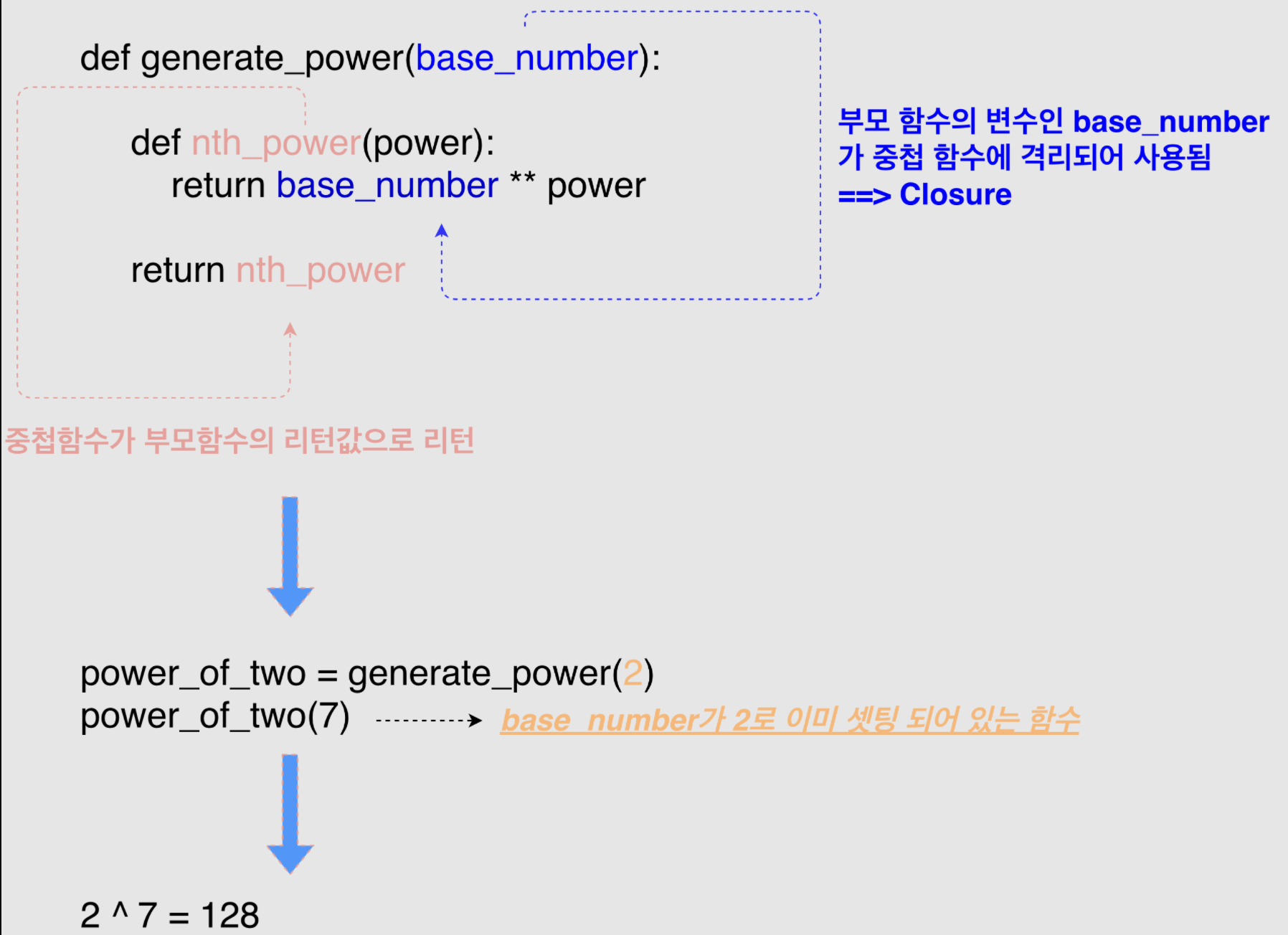
Decorator
-
사전적의미는 장식 / 뭔가 장식 관련된 걸 껄 ?
-
왠 파이선에 장식 ? 몬솔이야 ? 할꺼겠지만 한번 알아봅시다.
- 대박 주식 정보를 리턴하는 함수
def jackpot_stock_information(): return "계시가 내려졌습니다. 삼성전자를 사세요!- 이 정보는 유료회원만 받을 수 있다고 치고 / 해당 유저가 유료 회원인지 확인해 주는 함수
def is_paid_user(): return True- 항상
is_paid_user 함수가jackpot_stock_information 함수보다 먼저 호출 되야 되겠지 당연히 확인 먼저 해야하니까 ?
if is_paid_user(): jackpot_stock_information()- 근데 개발자가 사람이니까 위 함수를 여러곳에 쓸 때 헷깔려서 잘못 할 수도 있겠지 ?
-> 그럼 자동으로 먼저 호출되게 할 수 있는 방법은 없나 !?- 이때
Decorator쓴다 ! ! ! !
- 이때
-
Decorator사용법@사용 /()는 따로 안씀- 아래 식을 봐라 !
@is_paid_user # 장식(`@`)으로 달린 함수가 먼저 호출이 되고 난 후에 본 함수가 호출 def jackpot_stock_information(): return "계시가 내려졌습니다. 삼성전자를 사세요!"
-
어떻게 구현하냐 ? 암꺼다 다돼 ?
- 암꺼나 안돼고 ㅡ ㅡ ,
Decorator로 장식할 수 있는 함수는중첩 함수(nested function)을return하는 함수만decorator함수로 사용
-
즉 ,
decorator= chain of functions- func1 => func2 => func3 => ... => funcN
- 만일 다음 함수를 리턴하지 않고 다른 값을 리턴해버리면 그 다음 함수로 넘어가지 못하고 그냥 함수 실행이 종료되기 때문에
decorator함수는 그 다음 함수를 리턴해줘야함 -
is_paid_user 함수를decorator로 만들어 볼까요 ? ?
def is_paid_user(func): user_paid = True # 간단화 하기 위해 무조건 True def wrapper(*args, **kwargs): if user_paid: func() else: return return wrapper # 중첩함수"is_paid_user(func)"는 다음 함수인 "wrapper( )"를 리턴하지요 ?-> 방금 만든
is_paid_user 함수를decorator인@해주면 끝@is_paid_user def jackpot_stock_information(): return "계시가 내려졌습니다. 삼성전자를 사세요!"

실 사용법
decorator 사용
def trace(func): # 호출할 함수를 매개변수로 받음 def wrapper(): print(func.__name__, '함수 시작') # __name__으로 함수 이름 출력 func() # 매개변수로 받은 함수를 호출 print(func.__name__, '함수 끝') return wrapper # wrapper 함수 반환 ` @trace # @데코레이터 def hello(): print('hello') ` @trace # @데코레이터 def world(): print('world') ` hello() # 함수를 그대로 호출 world() # 함수를 그대로 호출hello 함수 시작 hello hello 함수 끝 world 함수 시작 world world 함수 끝
decorator 사용 안한거
decorator_closure.py def trace(func): # 호출할 함수를 매개변수로 받음 def wrapper(): # 호출할 함수를 감싸는 함수 print(func.__name__, '함수 시작') # __name__으로 함수 이름 출력 func() # 매개변수로 받은 함수를 호출 print(func.__name__, '함수 끝') return wrapper # wrapper 함수 반환 ` def hello(): print('hello') ` def world(): print('world') ` trace_hello = trace(hello) # 데코레이터에 호출할 함수를 넣음 trace_hello() # 반환된 함수를 호출 trace_world = trace(world) # 데코레이터에 호출할 함수를 넣음 trace_world() # 반환된 함수를 호출hello 함수 시작 hello hello 함수 끝 world 함수 시작 world world 함수 끝decorator 2개 사용
def decorator1(func): def wrapper(): print('decorator1') func() return wrapper ` def decorator2(func): def wrapper(): print('decorator2') func() return wrapper ` # 데코레이터를 여러 개 지정 @decorator1 @decorator2 def hello(): print('hello') ` hello()decorator1 decorator2 helloreplit 53번 문제 답
def welcome_decorator(func): def wrapper(): a = "welcome to WECODE!" b = func() return (b+a) # 위는 그냥 해도 됬었는데 이건 ;; 뭐지 근데 리턴값이 나와야하니까 여기 꼭 리턴값은 써주자 return wrapper ` @welcome_decorator def greeting(): return "Hello, " ` greeting()
Scope(범위)
-
프로그래밍 언어에서 scope은 어떠한 객체 (변수, 함수 등)가 유효한 범위를 이야기 하며, 범위를 벗어나면 해당 객체는 사용될 수 없습니다.
-
Python에서 scope은 항상 객체가 선언된 지점에서 위로는 상위 객체 까지, 아래로는 모든 하위 객체들과 그 안에까지가 범위 입니다.
4가지 Scope
- Local Scope (가장 좁은 범위)
- Enclosed Scope
- Global Scope
- Built-in Scope (가장 넓은 범위)
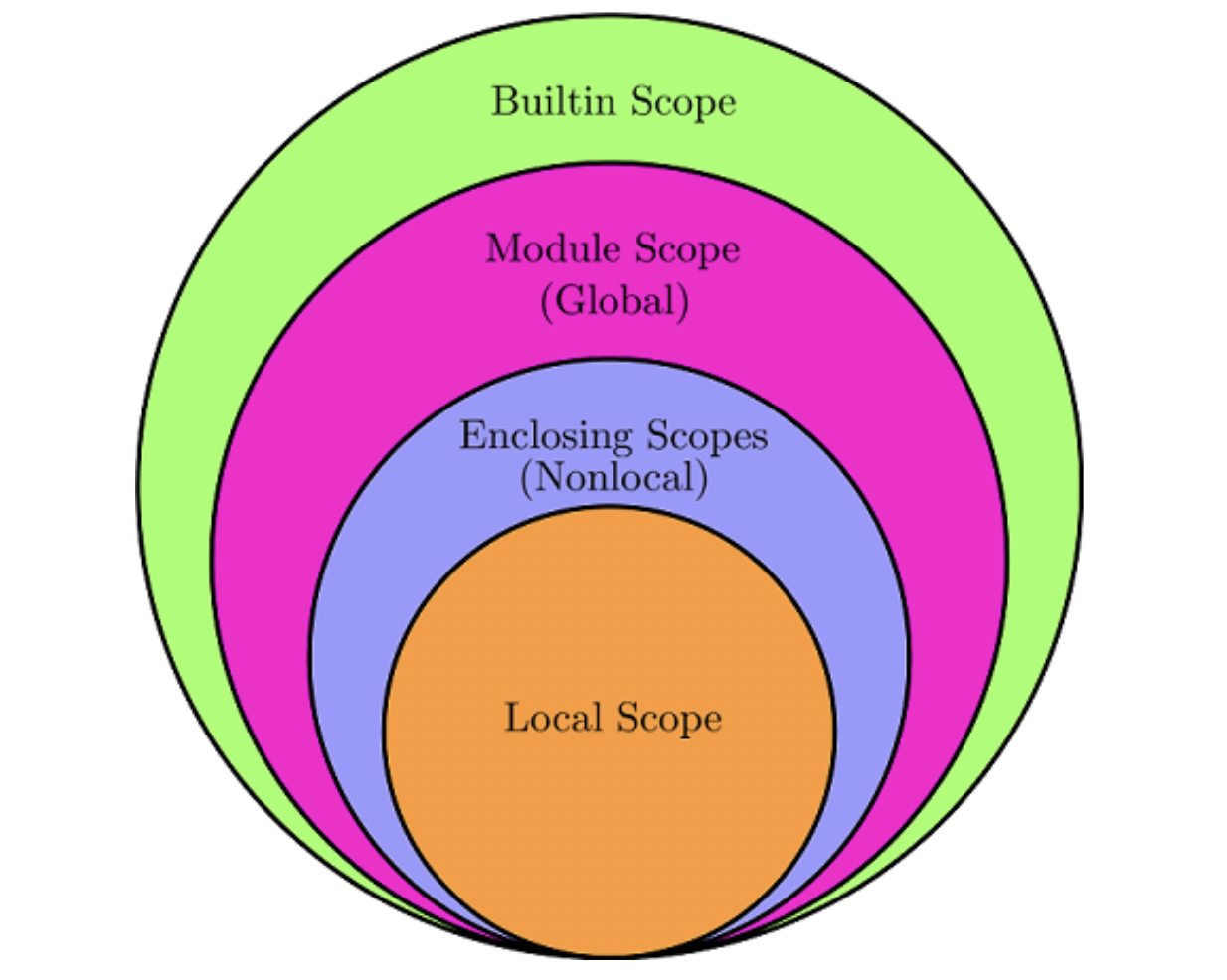
Local Scope
- 변수
나함수혹은객체`는 *특정(local) 범위**에서만 유효함수안에 들어가 있는변수나함수는 그 함수 안에서만 유효한다.
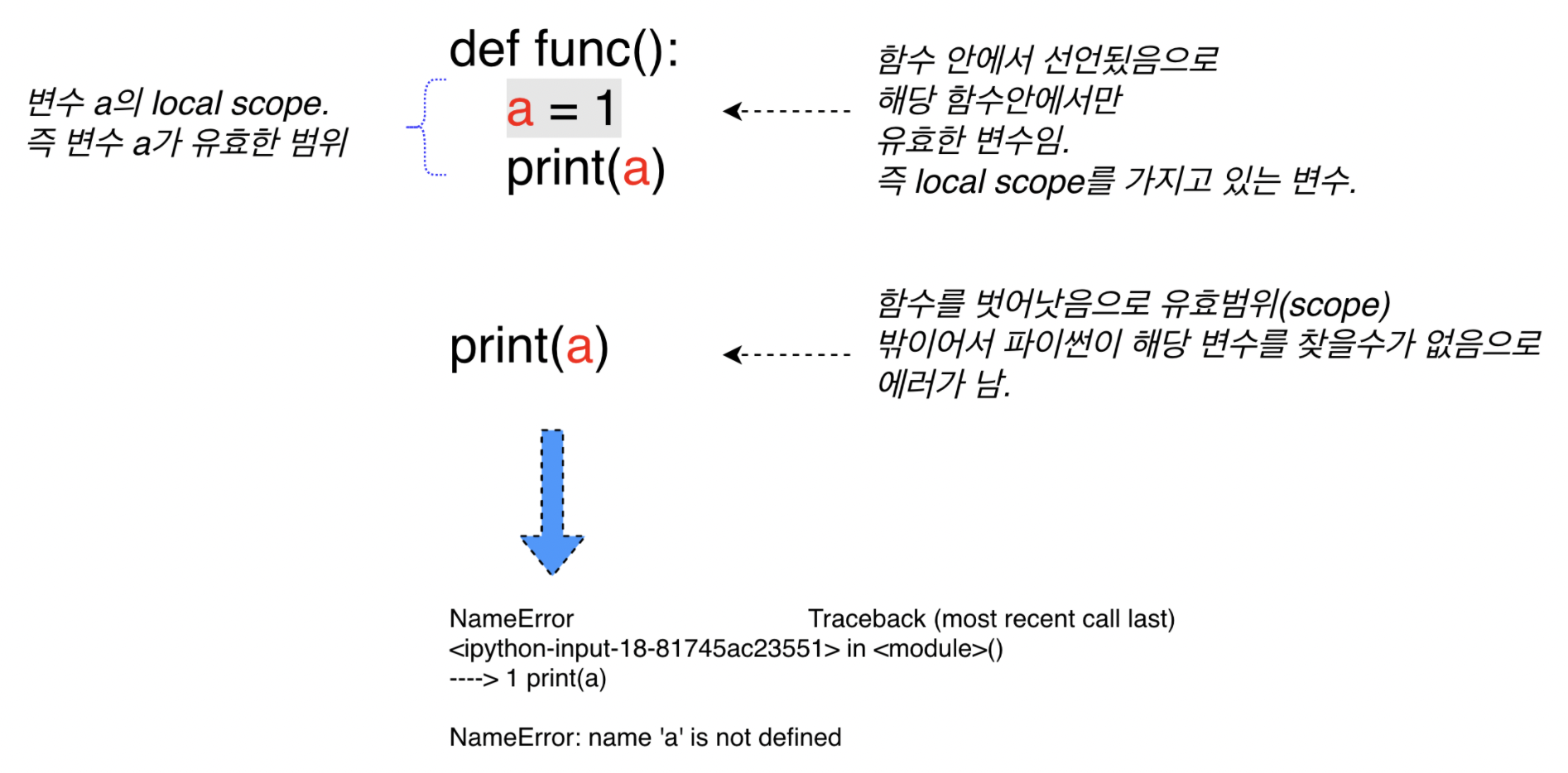
Enclosed Scope
-
중첩함수가 있을때 적용되는 Scope
- 부모 함수에서 선언된 변수는 중첩함수 안에서도 유효
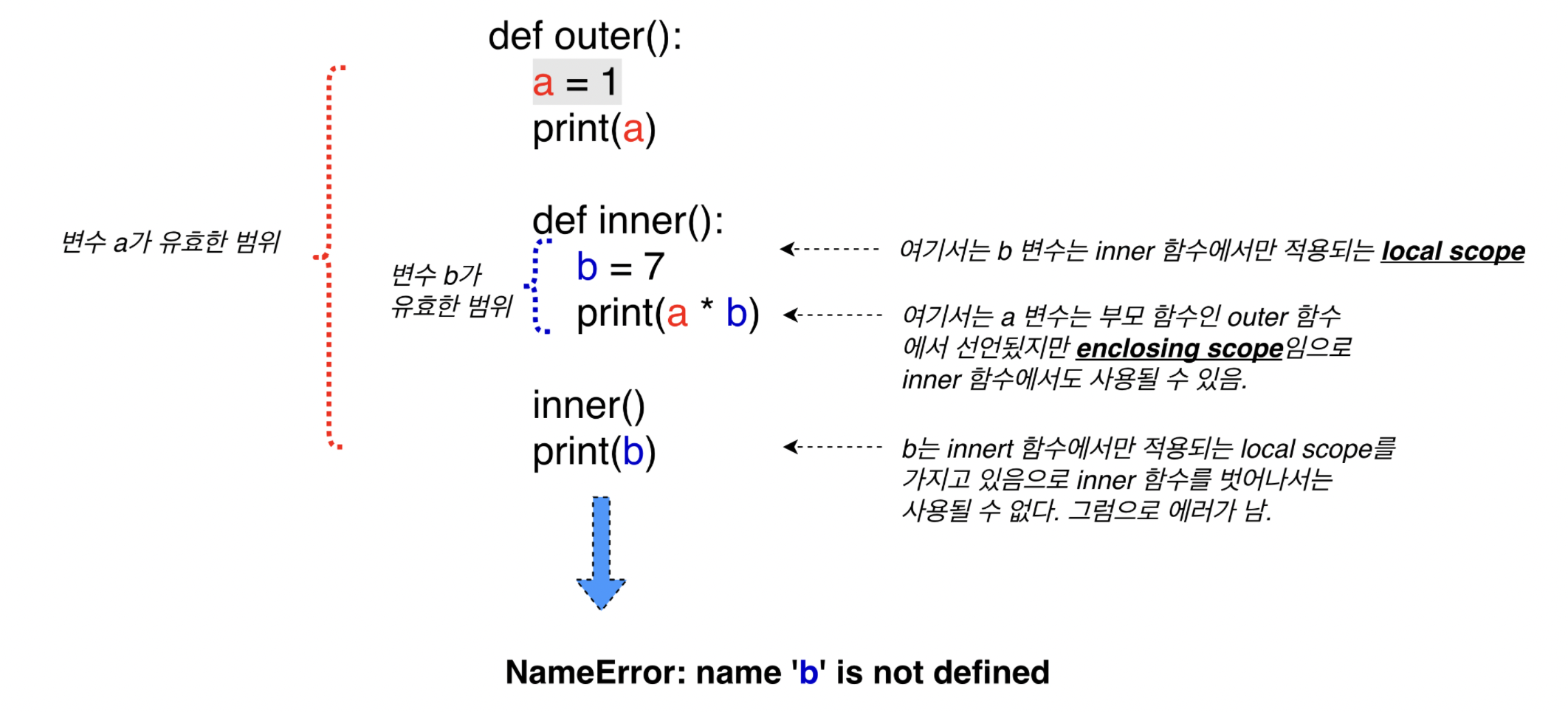
- 부모 함수에서 선언된 변수는 중첩함수 안에서도 유효
-
위의 방법을
ìdle출력하면1,7,none이렇게 나옴 -
아래로 하면 값만 딱 얻을 수 있당 ~ 참고해
def outer(): a=5 def inner(): b=7 return a * b return inner ` test = outer() print(test())35
Global Scope
- 함수 안에서 선언된것이 아닌 함수 밖에서 선언된
변수나함수변수와함수들이 해당 파일에서 가장 바깥쪽에서 선언되므로 해당 파일에서 선언된 지점 아래로는 다 유효한 범위를 가지고 있습니다
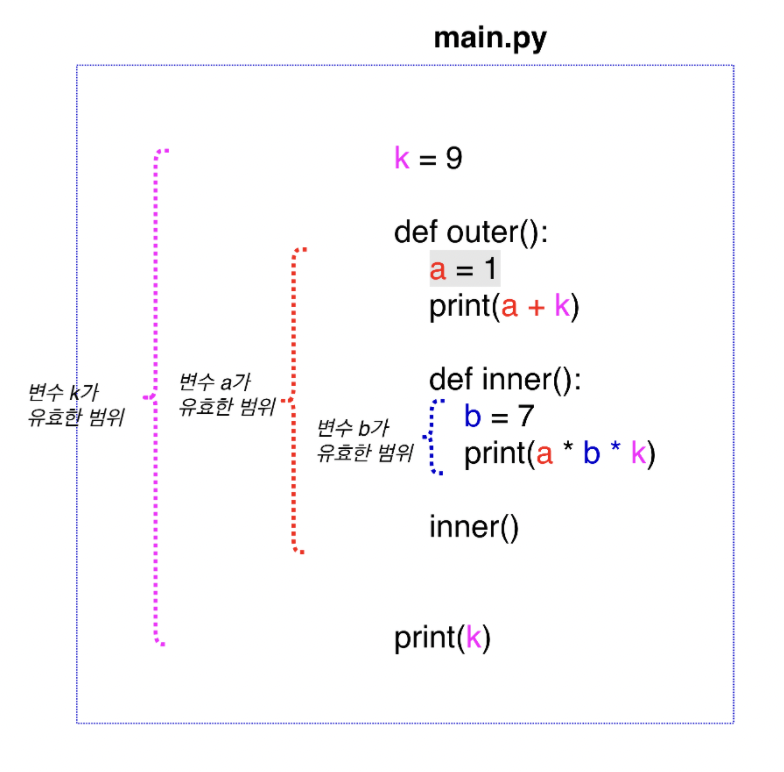
Built-in Scope
- 가장 광범위한 scope
- 파이썬이 제공하는 함수 또는 속성들이 built-in scope
- 따로 선언이 없이도 모든 파이썬 파일에서 유효한다
ex)len()
Shadowing
def shadowing()- 동일한 이름의 변수들이 서로 다른 scope에서 선언되었을떄, 더 넓은 범위에 있는 변수를 가지고 들이댄다
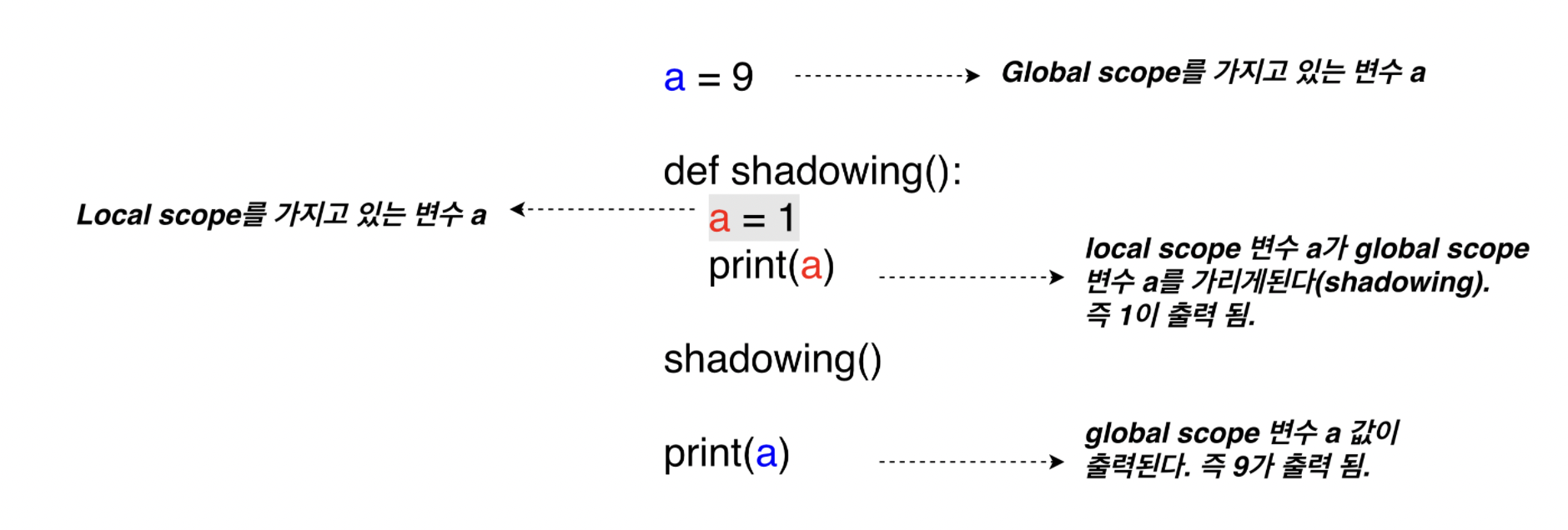
- 동일한 이름의 변수들이 서로 다른 scope에서 선언되었을떄, 더 넓은 범위에 있는 변수를 가지고 들이댄다
